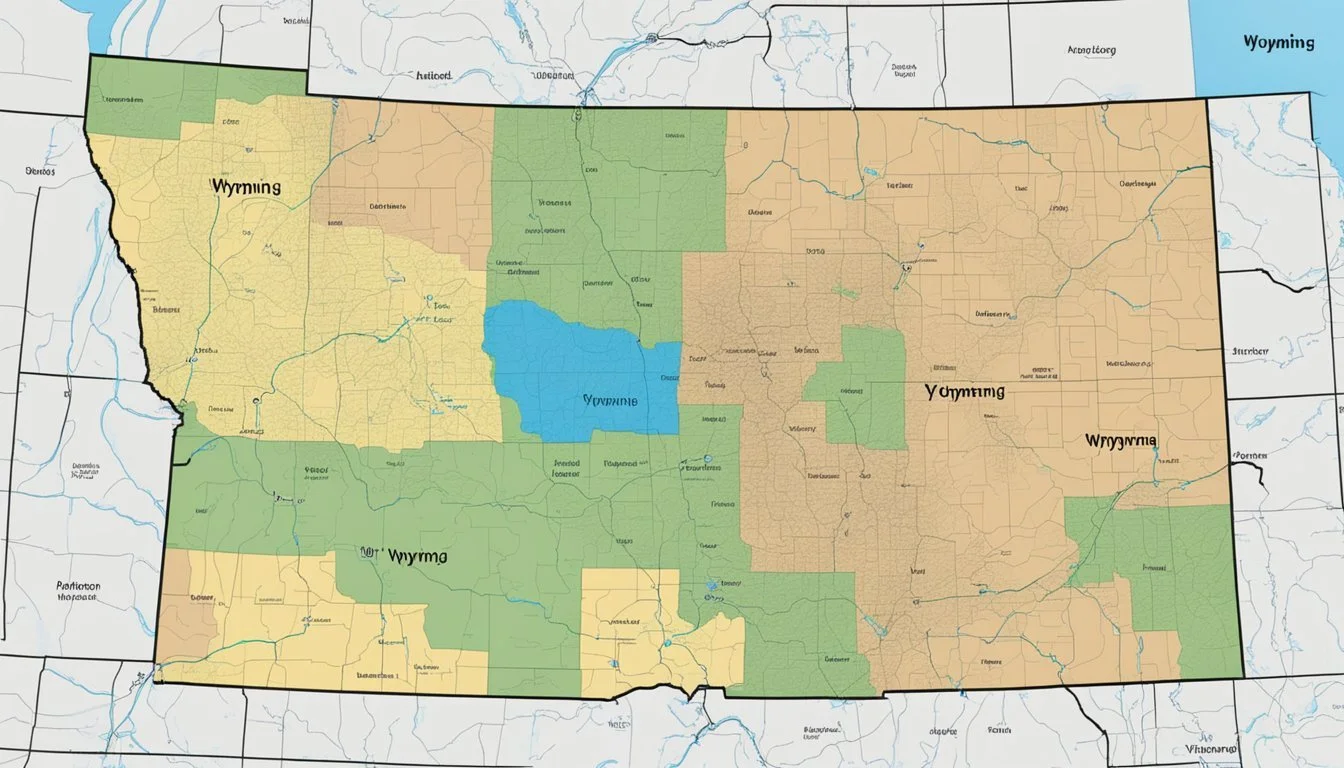Water Rights in Wyoming
Navigating Legal and Environmental Challenges
Water rights in Wyoming are deeply rooted in the state's history and play a critical role in the management and allocation of its water resources. Governed by the doctrine of prior appropriation, which is commonly summarized as "first in time, first in right," these laws prioritize water usage based on the seniority of the water rights. This system grants the holder of an older water right the privilege to use water before those with newer rights, particularly during times of scarcity. Wyoming's arid climate and the importance of agriculture have shaped a legal framework that emphasizes the reliability and predictability of water rights for landowners and other water users.
In Wyoming, the State Engineer's Office is a key authority in administering water rights, regulating the use of both surface and ground water. The regulatory framework ensures that water rights are treated as property rights, which can be bought, sold, and legally contested. There are strict rules concerning the abandonment of water rights, which require that water must have been available but remained unused for the abandonment to occur. As with other Western states, the interplay between water rights and land ownership can be complex and is of significant importance to state economy and livelihood.
The Wyoming Water Law provides mechanisms to protect senior water rights, including the prerogative for water right holders predating March 1, 1945, to initiate action to defend their rights to surplus water. This makes Wyoming's water law landscape a dynamic field with ongoing developments that have ramifications for the state's future. Through legal stipulations and court rulings, Wyoming continues to navigate the challenges of water resource management, always adjusting to meet the needs of its residents and ecosystems.
Historical Context and Legal Framework
The evolution of water rights in Wyoming reflects a unique legal framework developed to manage scarce water resources crucial for the state's development. This framework is grounded in both historical context and the specific legal principles that have regulated water use in Wyoming since its territorial days.
Evolution of Wyoming Water Law
Wyoming's arid climate necessitated the establishment of robust water laws, leading to the adoption of the Doctrine of Prior Appropriation—first in time, first in right. This doctrine became fundamental to Wyoming water law, allowing early settlers to secure water rights for mining, agriculture, and domestic use. The state of Wyoming continues to adhere to, and evolve this doctrine to balance the needs and rights of its water users.
State Government's Role in Water Rights
The State of Wyoming plays a pivotal role through its regulatory agencies, primarily the State Engineer's Office and the State Board of Control. The State Engineer is responsible for the administration of water rights, while the Board of Control adjudicates water rights and hears petitions for changes in usage.
Water Rights Administration and Enforcement
In Wyoming, water rights administration is a systematic and legally structured process requiring water users to obtain a permit for water appropriation. The State Engineer's Office oversees this, ensuring that water distribution is consistent with established priority dates and beneficial use principles.
Understanding Priority and Appropriation
Priority and appropriation are central to Wyoming's water law, dictating that earlier water rights have precedence over newer claims. Wyoming prioritizes the date of intent to put water to beneficial use as the determinant for settling competing claims, especially during times of water scarcity.
Jurisdiction and Legal Processes
Water rights disputes and adjudications in Wyoming typically fall under the jurisdiction of the State Board of Control and can be appealed to the District Court. The legal description of rights outlines the scope and nature of each appropriated water right, which becomes adjudicated upon approval or after legal contestation.
Legal Entities Involved with Water Rights
Entities such as individual water right holders, appropriators, and organizations managing irrigation projects are directly involved in the application, adjudication, and enforcement of water rights within Wyoming.
Wyoming Statutes and Regulations
Wyoming's water rights are codified in Wyoming Statutes and the water law's rules and regulations. These laws detail the processes for obtaining water rights, changing the point of use or nature of use, and seeking compensation for infringements upon established rights. The state's water law continues to shape management practices for Wyoming’s precious water resources.
Water Rights Acquisition and Control
In Wyoming, the acquisition and administration of water rights are governed by complex statutes which dictate how water resources are allocated and controlled. This process involves precise legal procedures to ensure that the rights to use water are granted and managed fairly, reflecting the state's recognition of water's vital role in its agricultural, industrial, and domestic spheres.
Application and Permitting Process
To acquire water rights in Wyoming, interested parties must navigate a permitting process that begins with applying to the State Engineer's Office. This process requires a filing fee and detailed information about the intended water use, source, and point of diversion. Applications are scrutinized for their adherence to state law and consideration of beneficial use, a key tenet in Wyoming's water law.
Certificates and Licenses Post-Adjudication
Once the permitting process is complete and water rights are adjudicated, a Certificate of Appropriation is issued. This certificate is evidence of the water right and specifies the terms of use. Continued compliance with those terms can lead to the issuance of a permanent license after submitting final proof of beneficial use to the State Engineer.
Board of Control's Extension and Approval Procedures
The Board of Control has the authority to grant extensions for developing water resources. In practice, this means the Board reviews requests to extend the time allowed for making proof of beneficial use. The Board's approval is necessary to solidify the water right.
Changes to Water Rights and Ownership
Changes in water rights, including transfers and changes in the point of diversion, type of use, or place of use, require approval to ensure that such modifications do not infringe on existing rights. The process involves filing an application with the state, reflecting the need for flexibility while preserving the rights of other water users.
Distribution and Beneficial Use Concepts
Wyoming law mandates that all water rights are exercised under the beneficial use concept, which is the lawful and efficient use of water. Distribution systems are in place to ensure that water rights holders receive their entitled share, according to priority dates and the specific allowances per water right.
Prioritizing Water Use and Preferred Uses
Water use in Wyoming follows the doctrine of prior appropriation, meaning that "first in time is first in right." Certain preferred uses have priority, such as those for domestic and municipal purposes followed by agriculture, livestock, recreation, and industrial purposes.
Water Rights for Specific Purposes
Rights are allocated for specific purposes to ensure the resource is used effectively, such as irrigation, municipal use, and domestic use. Wyoming laws also cover applications for other specific uses including water for steam power plants, steam and hot water heating plants, railway use, and storage.
The policies and procedures surrounding water rights acquisition and control in Wyoming are designed with a clear intent to balance the needs of individuals and various industries with the sustainable use of the state's water resources.
Water Management and Planning
Effective management and planning are crucial in Wyoming's water rights landscape, ensuring sustainable use and allocation of water resources across the state. This involves a cohesive strategy for water development, meticulous infrastructure projects, and stringent administration of both surface and groundwater.
State and Regional Water Management Strategy
In Wyoming, the regulation of water resources hinges on a collaborative state and regional strategy. The approach prioritizes the equitable distribution of water, accounting for both current needs and future demands. The state's framework is designed to uphold Wyoming water law, with a focus on integrating management initiatives across various water divisions.
Water Development and Infrastructure Projects
Wyoming's water development is an ongoing process involving water projects such as the creation of new reservoirs, enhancement of water storage facilities, and the implementation of irrigation projects. These initiatives contribute to a robust infrastructure that supports agricultural operations and sustains communities.
Surface Water and Groundwater Administration
The state administers surface water and groundwater rights using a priority system. Direct flow rights and permits for groundwater withdrawal are managed to balance usage, maintain environmental health, and prevent over-exploitation. This ensures that water resources remain available and are used effectively.
Water Division Superintendents' Duties
The Water Division Superintendent plays a pivotal role in overseeing water management in each of Wyoming's four water divisions. Their duties include administering water rights, adjudicating water disputes, and ensuring compliance with water law. They serve as the primary regulation authority within their respective jurisdictions.
Role of Water Administration Officials
Water administration officials are responsible for implementing the state's water management policies. They collaborate with local agencies to facilitate water development, manage the allocation of water resources, and enforce regulations. Their actions are integral to the state's water management system, striving for balanced and sustainable use of Wyoming's water assets.
Water Resources and Environment
In the arid landscape of Wyoming, managing water resources effectively is vital for the balance of ecosystems as well as the economy. This section discusses the interplay between water rights and environmental concerns, focusing on Wyoming's hydrology, aquatic life, agriculture, conservation efforts, and recreational water use.
Hydrologic Features in Wyoming
Wyoming's water resources are characterized by a mix of groundwater and surface water systems. The state is divided into seven major river basins: the Snake River, Yellowstone, Wind, North Platte, Laramie, Green River, Bighorn, Shoshone, and Niobrara. These rivers play a crucial role in local ecosystems and provide essential water supplies for various uses.
Aquatic Ecology and Fisheries Considerations
The health of aquatic life, particularly fisheries, is closely tied to the state’s waterways. The conservation of species like cutthroat trout often depends on the stream flow levels in rivers such as the Snake River and Yellowstone. Proper management of water rights is essential to maintain the delicate balance required for thriving fisheries.
Impact of Water Rights on Agriculture and Livestock
Agriculture and livestock represent major sectors in Wyoming's economy, relying heavily on water availability for irrigation and sustenance. The North Platte and Laramie Rivers are significant sources for agricultural water rights, which are subject to regulations to prevent depletion and ensure recharge rates remain sufficient.
Conservation and Environmental Concerns
Environmental conservation in Wyoming involves managing water rights to prevent adverse effects on ecosystems. Factors like evaporation rates and reservoir storage capacities are critical to maintaining environmental health, especially considering the dry climate and potential for water scarcity in areas like Riverton.
Recreational Use and Water Rights
Recreational activities on Wyoming’s waterways, such as fishing, boating, and wildlife viewing, contribute to the state's tourism industry. Water rights are influential in ensuring adequate water levels in major recreational spots like Bighorn and Green River, balancing the needs of the environment with recreational benefits.
Safeguarding Wyoming's water resources necessitates an understanding not only of legal frameworks governing water rights but also of the ecological and economic roles these resources play.
Mapping and Data of Water Rights
In the context of Wyoming, water rights documentation and analysis rely heavily on a combination of geographic information system (GIS) tools and comprehensive datasets. These resources are integral in managing and overseeing water resources effectively.
Documenting Water Rights with Maps
GIS technology affords precise tracking and visualization of water rights in Wyoming. Maps generated using GIS display various water-related features such as points of diversion, wells, points of use, and reservoirs. This spatial representation is critical for understanding the scope and limitations of water rights across the state. The Wyoming State Engineer's Office provides a GIS Search tool that enables individuals and organizations to view and create maps detailing these aspects.
GIS maps are not only vital for current water rights holders but are also essential for prospective applicants who need to understand the geographic limitations and opportunities for water usage. Integrating cadastral information, such as the Public Land Survey System (PLSS) and government-owned properties, these maps offer a comprehensive view of water rights relative to land ownership.
Additionally, these resources contribute to the overarching mission of the Wyoming State Engineer's Office to supervise the appropriation and distribution of water rights, guided by the prior appropriation doctrine. Effective mapping and database management are crucial in reinforcing the sustainable and legal use of Wyoming's water resources.
Technical Aspects of Water Rights
Navigating water rights in Wyoming entails understanding the practical details surrounding the construction and upkeep of water wells, recognizing the limits of groundwater and reservoirs, and assessing the variability and productivity of different water sources.
Construction and Maintenance of Water Wells
In Wyoming, water wells must be constructed according to state regulations to legally access underground water. Obtaining a water right typically begins with the application for a permit from the State Engineer’s Office to utilize water. The design and construction of each water well are critical to ensuring sustainable access to water and preventing contamination. Maintenance of these structures is equally important to secure a long-term water supply and to adhere to the legal stipulations governing water use.
Permit Application: Mandatory before construction
Well Design: Must comply with state regulations
Understanding Groundwater and Reservoir Capacity
The capacity of groundwater aquifers and reservoir storage determines the possible yield of a water source. It is essential for water rights holders to evaluate the range and capacity of these sources to estimate how much water can be legally and sustainably extracted. This understanding helps in making informed decisions about water usage and helps ensure compliance with Wyoming's water law.
Aquifer Capacity: Defines the sustainable extraction limit
Reservoir Levels: Influences available water for rights holders
Range and Yield of Water Sources
The range of a water source refers to the geographical area it covers, while the yield is the amount of water that can be extracted from it. Factors like climate, seasonality, and legal restrictions all influence these aspects. In Wyoming, the doctrine of prior appropriation dictates that "first in time, first in right" — meaning those with older water rights typically have a more secure claim to water resources, impacting both range and yield.
Prior Appropriation: Affects legal access based on priority date
Yield Variability: Can be influenced by environmental and legal factors
Legal and Administrative Challenges
Wyoming water rights management involves complex regulatory frameworks and legal stipulations aimed at balancing usage with sustainability. This section of the article elucidates the various administrative procedures and challenges that arise in the context of Wyoming water laws, focusing on dispute resolution, law excess and abatement, driller compliance, and the specific regulations surrounding domestic and stock wells.
Contested Water Rights and Dispute Resolution
When it comes to Contested Water Rights and their resolution, Wyoming operates under the doctrine of prior appropriation, often summarized by the phrase "first in time, first in right." Dispute resolution mechanisms have been established to handle conflicts that arise from competing claims. Adjudication processes are crucial in this respect, with the Wyoming Board of Control serving as a key authority in confirming and regulating water rights. Conflicts may escalate to the judicial system, where specific water rights decrees can provide resolution.
Addressing Excess and Abatement of Water Laws
Issues involving Excess Water Law can occur when water appropriated is not utilized, leading to potential abandonment of the right. Wyoming law requires that abatement action can be brought forth by water right holders against others if there's non-use of the water in question. It's crucial for right holders to be aware of the risk of losing rights through non-use and understand the legal framework that governs such situations.
Driller's Obligations and Compliance
Individuals or entities responsible for drilling wells must adhere to a set of legal obligations and ensure compliance with multiple layers of regulation, such as the Wyoming State Engineer's Office rules. This includes obtaining the necessary permits before drilling and adhering to specific drilling and construction standards designed to protect water resources and other water rights holders.
Handling Domestic and Stock Well Regulations
Lastly, regulations surrounding Domestic and Stock Wells differ from other water rights in Wyoming. Property owners are usually allowed to drill domestic wells without securing water rights permits, provided the water usage is within set limitations. Stock wells used for watering livestock often require permits, and both domestic and stock wells must comply with regulations that ensure the sustainable use of groundwater resources.
Handling legal and administrative issues related to water in Wyoming demands a thorough understanding of the state's water laws to navigate the complexities effectively. It's essential for rights holders and other concerned parties to remain informed about their responsibilities and the ever-evolving legal landscape.
Future Outlook and Amendments
In addressing the future of water rights in Wyoming, one must consider both the trajectory of current trends and the possible legislative changes. These factors will shape the forthcoming landscape of water usage and management within the state.
Forecasting Water Rights Trends
In Wyoming, they must navigate a complex interplay of increasing demand and limited water supply, particularly in the context of the Upper Colorado River Basin commitments. Projections indicate that by 2025, there may be mandatory water cuts that could significantly affect state allocations, necessitating a proactive response in water management and legal frameworks.
Potential Amendments to Wyoming Water Law
Legislative changes may include amendments that provide clear definitions and stronger enforcement mechanisms for water conservation efforts. Revisions are being considered to address the efficient use of water and preserve the ecological integrity of waterways. Some of these amendments can be seen in proposed legislation such as the Wyoming Legislature's bill on temporary changes of water use, which aims to fine-tune current water law without compromising existing rights.
Modernization and Adaptation Strategies
Modernization efforts focus on the integration of technology for better water rights management, with an emphasis on data collection for accurate water forecasting. They also include exploring new methods of water conservation that are sustainable and economically viable. Adaptation strategies may require shifts in the traditional water rights paradigm to incorporate flexible water-sharing agreements that reflect the needs of a changing climate and evolving agricultural practices. These strategies are pivotal in cooperating with regional entities like the Upper Colorado River Commission for cohesive water management across state lines.
Frequently Asked Questions
In Wyoming, water rights are a critical aspect of land management and resource allocation. Understandably, many property owners and businesses have questions about how these rights are allocated, regulated, and enforced.
How are water rights allocated and regulated in Wyoming?
Water rights in Wyoming are premised on the doctrine of prior appropriation, meaning they are allocated based on a system of "first in time, first in right." The Wyoming State Engineer's Office oversees the administration of water rights, ensuring that rights are granted for specific purposes and tracked by their priority dates.
What is the process for obtaining a water permit in Wyoming?
To obtain a water right, individuals must submit an application to the State Engineer. The application is reviewed, and if it meets statutory requirements, the State Engineer may issue a permit for the use of water.
Can landowners in Wyoming drill wells without a permit?
In Wyoming, most uses of groundwater, including drilling new wells, typically require a permit from the State Engineer. A permit ensures that the groundwater use does not infringe upon the rights of other water users.
In Wyoming, how is water priority determined between different rights holders?
Water priority in Wyoming is determined by the date of the water right's establishment. This priority date is crucial in times of scarcity, where water is allocated to rights holders in order of the oldest priority date first.
What laws govern the use of surface water for irrigation purposes in Wyoming?
The use of surface water for irrigation in Wyoming is governed by state statutes which stipulate that any changes in the point of diversion must be recorded with the State Engineer or Board of Control, especially for changes made after 1965. This ensures that irrigation practices adhere to established water rights and priority dates.
Who is responsible for managing and enforcing water rights in the state of Wyoming?
The Wyoming State Engineer's Office bears responsibility for managing and enforcing water rights. The office is tasked with the regulation of the state's waters, administering rights, and ensuring compliance with state water law.








